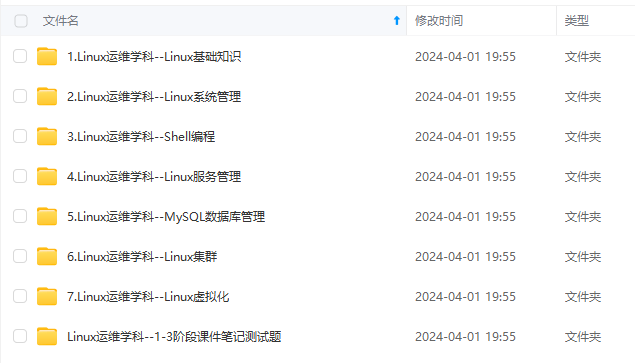先自我介绍一下,小编浙江大学毕业,去过华为、字节跳动等大厂,目前在阿里
深知大多数程序员,想要提升技能,往往是自己摸索成长,但自己不成体系的自学效果低效又漫长,而且极易碰到天花板技术停滞不前!
因此收集整理了一份《2024年最新Linux运维全套学习资料》,初衷也很简单,就是希望能够帮助到想自学提升又不知道该从何学起的朋友。





既有适合小白学习的零基础资料,也有适合3年以上经验的小伙伴深入学习提升的进阶课程,涵盖了95%以上运维知识点,真正体系化!
由于文件比较多,这里只是将部分目录截图出来,全套包含大厂面经、学习笔记、源码讲义、实战项目、大纲路线、讲解视频,并且后续会持续更新
*Field*: 筛选字段位于筛选范围的位置(第几行或列);
*Criteria1*:筛选条件;
*Operator*:指定筛选器类型的 XlAutoFilterOperator 常量,通常对筛选的结果设置要求,如 Operator:=xlFilterValues表示筛选目标字段的数值;
*Criteria2*:第二筛选字段,与 Criteria1 和 Operator 一起组合成复合筛选条件;
*SubField*:这个是针对新增的特殊数据类型(股票和地理)有效,一个单元格里的数据可包含多项数据,365和web版限定参数,一般不用。
*VisibleDropDown*:如果为 True,则显示已筛选字段的 AutoFilter 下拉箭头,false则隐藏。
注意,以上参数都是可选参数。
下面给出两个实例:
Case 1.筛选指定区域里的参数结果:
'选择啤酒字段的所有值
Worksheets(“Data”).range(“A2:C10000”).Autofilter _
(2,“啤酒”,xlFilterValues)
上述代码含义是在名为“Data”的工作表中“A2”到“C10000”范围内的第2列筛选出“啤酒”字段的值;
一般情况下其余参数可省略。
通常情况下,上述代码会写成这样:
'选择啤酒字段的所有值
Worksheets(“Data”).range(“A2:C10000”).Autofilter _
(Field:=2,Criteria1:=“啤酒”,Operator:=xlFilterValues)
这段代码含义和上一段代码含义和作用一样,那为什么要写得更复杂呢?这是因为如果你写参数时严格按照Autofilter的顺序来表达每个参数,可以写成第一段代码形式,但是实际工作中大家不会需要所有字段,书写顺序也不一定严格按照Autofilter的顺序来写,为避免参数设定错误,将参数具体对应设定比较安全,同时代码可读性也更好。
Case2.筛选动态区域里的参数结果:
'选择啤酒字段的所有值
Worksheets(“Data”).range(“A1”,[C1].end(xldown)).Autofilter _
(Field:=2,Criteria1:=“啤酒”,Operator:=xlFilterValues)
这段代码和Case 1最大不同就是筛选范围是动态的,即A列和C列包含数据的区域,需要注意的是,range(“A1”,[C1].end(xldown))来表示活动区域时,如果运行的工作表不止一个,需要写成range(“A1”,sheets(“Data”).[C1].end(xldown)).
当有Criteria2时,与Criteria1 类似,在Autofilter里加进去即可,就可以用2个条件进行复合筛选;
'选择啤酒,面包字段的所有值
Worksheets(“Data”).range(“A1”,[C1].end(xldown)).Autofilter _
(Field:=2,Criteria1:=“啤酒”,Operator:=xlOr,Criteria2:=“面包”)
但是,上述代码最多只能进行啤酒”,“面包”两个字段“的筛选,如果想进行3个及以上字段的筛选呢?这个时候,可以采用一维数组Array来解决这个问题;
'选择啤酒,面包,香肠字段的所有值
Worksheets(“Data”).range(“A1”,[C1].end(xldown)).Autofilter _
(Field:=2,Criteria1:=Array(“啤酒”,“面包”,“香肠”),Operator:=xlFilterValues)
当筛选的字段总数为多个(>=5)时,而需要进行筛选的字段也为多个时,除了用数组,可以也采用反向筛选的方法;
'选择除了猪排以外的字段的所有值
Worksheets(“Data”).range(“A1”,[C1].end(xldown)).Autofilter _
(Field:=2,Criteria1:=“<>猪排”,Operator:=xlFilterValues)
假定所有字段分别为“啤酒”,“面包”,“香肠”,“牛排”,“蛋糕”,“猪排”,需要筛选除“猪排”外所有字段,与此类似,如果反选有“猪排”和“蛋糕”两个字段,Criteria2参数加上即可,如下述。
'选择除了猪排,蛋糕以外的字段的所有值
Worksheets(“Data”).range(“A1”,[C1].end(xldown)).Autofilter _
(Field:=2,Criteria1:=“<>猪排”,Operator:=xlOr,Criteria2:=“<>蛋糕”)
综上所述,结合正向筛选和反向筛选字段的方法可以将VBA Autofilter用得比较灵活,基本可以解决所有的筛选问题;
但是,有人可能会好奇,既然正向筛选可以进行3个及以上字段的筛选,那么反向筛选是否可以实现呢?
首先,需要明确的是,Autofilter的方法没有3个及以上的Criteria,因此无法用CriteriaX的方法实现;其次,前面采用一维数组实现多个字段正向筛选,那么反向筛选可以么?
例如↓
'选择除了啤酒,面包,香肠以外的字段的所有值
Worksheets(“Data”).range(“A1”,[C1].end(xldown)).Autofilter _
(Field:=2,Criteria1:=Array(“<>啤酒”,“<>面包”,“<>香肠”),Operator:=xlFilterValues)
### 最后的话
最近很多小伙伴找我要Linux学习资料,于是我翻箱倒柜,整理了一些优质资源,涵盖视频、电子书、PPT等共享给大家!
### 资料预览
给大家整理的视频资料:

给大家整理的电子书资料:

**如果本文对你有帮助,欢迎点赞、收藏、转发给朋友,让我有持续创作的动力!**
**网上学习资料一大堆,但如果学到的知识不成体系,遇到问题时只是浅尝辄止,不再深入研究,那么很难做到真正的技术提升。**
**[需要这份系统化的资料的朋友,可以点击这里获取!](https://bbs.csdn.net/forums/4f45ff00ff254613a03fab5e56a57acb)**
**一个人可以走的很快,但一群人才能走的更远!不论你是正从事IT行业的老鸟或是对IT行业感兴趣的新人,都欢迎加入我们的的圈子(技术交流、学习资源、职场吐槽、大厂内推、面试辅导),让我们一起学习成长!**
友,可以点击这里获取!](https://bbs.csdn.net/forums/4f45ff00ff254613a03fab5e56a57acb)**
**一个人可以走的很快,但一群人才能走的更远!不论你是正从事IT行业的老鸟或是对IT行业感兴趣的新人,都欢迎加入我们的的圈子(技术交流、学习资源、职场吐槽、大厂内推、面试辅导),让我们一起学习成长!**






















 2947
2947











 被折叠的 条评论
为什么被折叠?
被折叠的 条评论
为什么被折叠?








